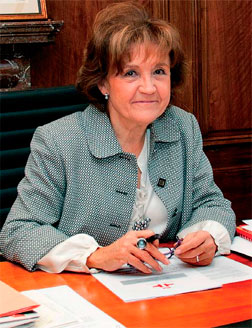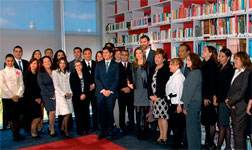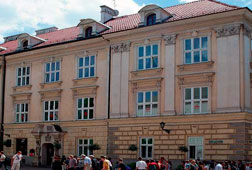Interview with Carmen Caffarel. Former Head of Instituto CervantesMiscellaneous
Carmen Caffarel was born in Barcelona in 1953. As daughter of the actor José María Caffarel, she moved to Madrid at the age of nine because, as she explains, there were better work opportunities for her father: “Everything happened in Madrid: cinema, theatre, television.” She obtained a degree in Spanish Language, Literature and Linguistics at University Complutense in Madrid and in 1988 was awarded a Cum laude doctorate by the same university in Spanish Linguistics. She specialized in social communication because, as she states “linguistic studies did not provide me with answers as to why, if we use a common language and same codes, we cannot often understand each other”.
From 1988 to 2000, she was a University Professor of Communication Theory and Research Methods at the Information Science Faculty of the University Complutense. She was also the vice-dean for Students, Internal Communication and International Relations of that faculty from 1994 to 1998. Professor and assistant vice-chancellor of Students and International Relations for Rey Juan Carlos University in 2002 and, 2003 she was elected Head of the Department of Communication Sciences of the Rey Juan Carlos University.
On the 23rd April, 2004, Caffarel was appointed by the Government as General Director of the Spanish Radio and Television Company. She left the position in January 2007 after undertaking a deep remodelling and modernization of the state entity which became the RTVE Corporation. On 13th July of the same year, she was appointed Head of Instituto Cervantes, leaving the position in January of 2012 to take up her professorship again in Audiovisual Communication at the Rey Juan Carlos University.
She is co-author of various studies on the Spanish language and has published several articles, in different specialized magazines, mainly related to communication, the news media and television.



©Instituto Cervantes

Headquarters. Madrid
©Instituto Cervantes

Headquarters at New York.
©Instituto Cervantes

©Instituto Cervantes


©Instituto Cervantes

©Instituto Cervantes
“Spanish language, as a cultural industry, makes a 15% contribution to our GNP”
Spanish is spoken by 500 million people worldwide, the second mother tongue, the first being Chinese and the most studied after English. It is the official language in 21 countries and several scattered communities such as that of the Sephardi Jews.
Since its foundation in 1991, Instituto Cervantes has promoted and coordinated efforts to spread the Spanish and Latin-American language and culture around the world. In this interview, Carmen Caffarel*, former Head of this institution, talks about its objectives and concerns and of the progression of Spanish as a language for communication.
(*At the time of this Trébol issue going to press, Carmen Caffarel was relieved of her duties as Head of Instituto Cervantes. The editorial team decided to go ahead with the publication of her opinions in view of Ms Caffarel´s interesting answers and the informative nature of her comments and statements, which are a reflection of her extraordinary experience in running the Institute for more than four years.)
Would you consider the Management of Instituto Cervantes to be a political position? What are its objectives?
I think it requires more a technical profile. My predecessors at Instituto Cervantes (IC) have all been very suited to the position. They have academic or cultural backgrounds, such as writers or historians with managerial experience. The IC is a very complex institution, quite decentralised being present in over 44 countries but free to apply what it considers to be the most appropriate policies in order to achieve its objective. This is to promote Spanish, co-official languages and Spanish culture (not only from Spain but also from Latin America, that of over 500 million people who share the same language) in the non-Spanish speaking countries.
The objective of the IC is to promote Spanish and the Spanish culture, in the non-Spanish speaking countries
Its mission is plural, creative and spans all cultural subjects. Moreover, it tries to make Spanish recognised in other countries as a language of culture, economy and great tradition. It also attempts to influence education programmes so that Spanish is learnt from an early age, because those young people will be our future leaders.
The economic impact of Spanish
When does a language of communication become an industry that is noteworthy for its economic impact?
Language generates income and it is an unequivocal industry of culture. But it is not so easy to state when they become prominent. The case of Spanish is significant because being a language with a vast culture, it is considered useful for several reasons; the main one being for those that study it and their enhanced chances of finding work in Spanish speaking companies.
Is it possible to evaluate the contribution of Spanish to the economy of Spain?
The economic value of Spanish has already been quantified. This was done many years ago by Professor Martín Municio in an initial study1. Another research has now been carried out by Professor García Delgado2, sponsored by Fundación Telefónica, that is providing with very encouraging data. Its contribution, together with all of the cultural activities, represents around 15% of the GNP. Within this percentage, we are including everything from an Erasmus student who comes to Spain to study to text books, theatrical activities and artists or actors of international renown.
Will Spanish continue being a contributor to the economic growth?
Being more and more people speaking Spanish, the consumption of culture industry in Spanish is inevitable, whether that is through text books or travel. Spain is increasingly attractive as a touristic, linguistic and cultural destination. In this respect, data indicate that culture is not an expense but rather a quantifiable and intangible investment.
1 Angel Martín Municio (2003). El valor económico de la lengua española. Espasa- Calpe.
2 “El valor económico del español: una empresa multinacional”, by José Luis García Delgado, Professor of Economics at the Complutense University. Fundación Telefónica.
The IC presumably has a diplomatic role since it has to deal with Heads of State and government on different events.
In a way, this is true because our goals are related to this soft power which is, in fact, so important in international relations. The participation and communication of the IC and other renowned institutions is considered very positive in events such as Premios Príncipes de Asturias (Prince of Asturias Awards) which highlight us as excellent ambassadors for Spain. We are working with something that does not present a problem; on the contrary, it contributes to an inter-cultural dialogue so that we can get to know each other better.
The figure for Spanish speakers has now reached 500 million, if native to those countries that speak Spanish and those that speak it as a second language are taken into account
Why was the IC set up? What is its vision and mission?
Once Spain had overcome the transition to democracy and international relations were re-established, President Felipe González government thought about the need to create an institution similar to the British Council and other comparable to French, Italian and German organizations in order to spread the Spanish language and culture throughout the non- Spanish speaking world. So, the IC was born in 1991 and we celebrated our 20th anniversary in 2011. Originally, we were seeking the same objectives as the institutes in other countries but with certain differences. The most significant and successful one has been not to concentrate only on the spreading of the culture of Spain but rather the culture in Spanish; that is to say, for culture in Spanish, Camilo José Cela is as important as Carlos Fuentes, García Márquez or Vargas Llosa, amongst others. This means that we become very prominent in the area of culture, and we are not just talking about literature. We are working with all of the Latin American embassies which offer us a wide projection compared to other similar institutions, such as the Goethe Institute for example, which only promotes German culture when it could also include Austrian culture.
Where and how has the IC developed?
We are present in 44 countries and have 77 locations including centres and classrooms. We can be found in the five continents where the centres have their own staff, management teams and provide both Spanish lessons and training for the teachers.
Another distinctive feature is that we issue the Spanish as a Foreign Language Certificate (DELE), an official qualification for knowledge of Spanish. It is granted by Spain´s Ministry of Education and is available worldwide. There are currently over 600 universities that offer teaching and examinations for obtaining this qualification. This is really positive because of the results that can be derived socially and economically. Last year, in Mexico, we reached an agreement with the over 100 universities of the Universia network whereby they would have the possibility of obtaining our qualification, provided they guaranteed a status, a quality certification.
What position does Spanish hold in the world?
According to reliable and verifiable sources, the figure for Spanish speakers has now reached 500 million, if native to those countries that speak Spanish and those that speak it as a second language are taken into account. These data make it the second mother tongue in the world after Chinese. Moreover, it is important to emphasize the recognition of the communicability of Spanish which is at 95%. In the Internet, it is the third language, after English and Chinese. We have a quota of around 8% and 132 million users but this is due to the so-called digital gap. If all Spanish speakers had access to Internet, it would increase strikingly. After Spanish, there is Japanese with 5.6%, French with 4.6% and German with 4.4%.
These are outstanding figures.
Yes they are. But we should also be looking at growth. Spanish is the most studied second foreign language, after English. A few weeks ago, we presented the results of an important research which has taken more than two years and was undertaken together with the British Council as we are always asking ourselves whether, one day, Spanish will overtake English. However, that is not the question; the message that we need to convey is that anyone in the world who speaks English and Spanish has a great advantage for communicating.
The message that we need to convey is that anyone in the world who speaks English and Spanish has a great advantage for communicating
In one of your presentations, it was pointed out that a North American who could speak Spanish as well as English, could have a salary difference of USD 8,000.
Around USD 7,000 or 8,000 per year. This information was released by the American census and we published it in a study on Spanish in the USA where several variables were being analysed and in this case, reference was made to people who spoke well both languages. We should not forget that the Latin American community is increasing its presence, so it is achieving greater political and economical influence. The census data provided by the USA refers to a research carried out in 2007 being published two years later. The rate of growth of Spanish in the USA is going to turn it into the first Spanish speaking country, surpassing Mexico. Recent projections indicate that by 2050, 40% of youngsters will be of Latin American origin. Practically we may say that the American continent will speak Spanish from North to South.
It is sometimes forgotten that the earliest city in the USA of today is San Agustín and that it was founded by the Spaniards in 1565 in the North of Florida. Since then, San Agustín has been continuously inhabited and in 2015 San Agustín will celebrate the 450th anniversary of its foundation. In comparison, the first English town was Jamestown in Virginia and was founded in 1607.
Spanish tradition and the Latin American footprint are very strong. There have been magnificent exhibitions on this subject. As time goes by, the North Americans’ recognition of the Spanish contribution is increasing but there is still a lot of work to be done to make them aware of the Spanish influence in the founding of their first cities.
Brazil, Africa and The Philipines
What does it mean for Brazil that Spanish, as an optional subject, has been introduced into the official education system?
Brazil constitutes a real boom, at least from the figures point of view and following the introduction of the Lula law, where Spanish was introduced in the official education systems as an optional subject. Data shows that in two years, the number of students has increased from one to five million. We signed an agreement there with the Ministry of Education, whereby our online Spanish course from the Cervantes Virtual Centre (CVC) could reach all the corners of a country, which is a continent in itself, training the teachers in the use of these tools.
There has been talk of the need for 45,000 Spanish teachers in Brazil. Have you been very active in this process?
Our eight centres in Brazil have their daily dynamic which comprises those who are going to learn Spanish there and/or the Latin American cultural exhibitions, as well as the work undertaken with the universities and ministries to help training the Spanish teachers in the use of the IC tools, such as DELE or the Cervantes Virtual Centre.
Apart from the interest in learning Spanish that has arisen in the Asian Pacific zone, there are still some areas to be covered, such as Africa.
In twenty years we have advanced tremendously but there is still a lot more to do. Interest in Africa does not surprise me. Looking towards Europe from Africa, Spain is the first country that you see and, besides, a Spanish speaking continent can be found to the East.
For the first time, we have opened an Aula Cervantes in the Sahara area in Dakar (Senegal), and there are 300,000 people studying Spanish because it provides the opportunity to communicate with 22 countries. It is a useful language. When we ask our students the reason why they study Spanish, we get different answers. In Europe, our neighbours appreciate the language for the great cultural tradition of Spain but, in Africa, the reason is to improve; to have the possibility of finding work and prosperity.
What is the position in Equatorial Guinea, the only Spanish speaking country in Africa that was almost considered on the road to being absorbed by the francophone influence?
Spanish is still spoken in Guinea. We work there and we are in contact with their writers and cultural world. It is a country with its own dynamics within a broad linguistic community.
How is Spanish doing in the Philippines?
Spanish was the official language up until 1973 when the country decided to adopt English but, the truth is, we are starting to recover our influence. In this respect, two years ago we signed an agreement with the Philippine Ministry of Education to finance the education of teachers with the objective of getting Spanish back into schools. There is now a political recognition of how useful Spanish can be and we should not forget that the Philippines share an ocean with a large part of Latin America. By way of an anecdote, the Minister for Foreign Affairs told me that he requires that every one of his staff that travels must speak Spanish.
Are there budgetary restrictions due to the current crisis?
We cannot ignore the crisis but the truth is that, within the cuts made over the last two years, where the Government Budget average for Ministries was 15%, our cuts were 4% one year and 2% the next. I think that it is as a result of the recognition of the promotional work and its international nature, as well as for the achieved growth. This Institute is also open to private finance. We do have a guaranteed contribution from the Ministry of Foreign Affairs (the budget for 2011 via Government Budget was of EUR 102 million), which we seek to complement with private funds. This is achieved through income from registrations, DELE exam fees and teacher training courses; very much along the lines of other institutions. It is completed with sponsorship in material or monetary contributions. These sponsorships are channelled through the Circle of Friends of the IC and it usually involves large corporations that are aware of the reciprocity character of this kind of cooperation. One of the reasons why we have an international reputation is because we help companies to teach Spanish to their staff. On their side, companies support us with monetary or other types of contribution. It is all based on effectiveness and efficiency since, one and one do not make two but much more because this enables us to organise it from the start and to generate a widespread cultural coverage with greater projection and less money.
Network of centers Instituto Cervantes
- Germany: Berlin, Bremen, Francfurt, Hamburg and Munich
- Algeria: Argel and Oran
- Australia: Sydney
- Austria: Viena
- Belgium: Brusels
- Brazil: Rio de Janeiro, São Paulo, Salvador de Bahia, Brasilia, Curitiba, Porto Alegre, Recife, Belo Horizonte
- Bulgaria: Sofia
- Canada: Calgary
- China: Beijing and Shanghai (Miguel de Cervantes library)
- Cyprus: Nicosia
- South Corea: Seoul
- Croatia: Zagreb
- Egypt: Alexandria and Cairo
- Slovakia: Bratislava
- Slovenia: Ljubljana
- United States: Albuquerque, Boston, Chicago, New York and Seattle
- Philippines: Manila
- France: Bordeaux, Lyon, Paris and Toulouse
- Greece: Athens
- Hungary: Budapest
- India: New Delhi
- Indonesia: Jakarta
- Ireland: Dublin
- Israel: Tel Aviv
- Italy: Milan, Naples, Palermo and Rome
- Japan: Tokyo
- Jordan: Amman
- Lebanon: Beirut
- Malaysia: Kuala Lumpur
- Morocco: Casablanca, Fez, Marrakech, Rabat, Tangier and Tetouan
- Netherlands: Utrecht
- Poland: Krakow and Warsaw
- Portugal: Lisbon
- United Kingdom: Gibraltar, Leeds, London and Manchester
- Czech Republic: Prague
- Romania: Bucharest
- Russia: Moscow
- Senegal: Dakar
- Serbia: Belgrade
- Siria: Damascus
- Sweden: Stockholm
- Tunisia: Tunisia
- Turkey: Istanbul
- Viet Nam: Hanoi

List of the 21 countries, provided by the IC, in which Spanish is the official language. Source: Instituto Cervantes
- Argentina
- Bolivia
- Chile
- Colombia
- Costa Rica
- Cuba
- Ecuador
- El Salvador
- Guatemala
- Ecuatorial Guinea
- Honduras
- Mexico
- Nicaragua
- Panama
- Paraguay
- Peru
- Puerto Rico
- Dominican Republic
- Spain
- Uruguay
- Venezuela
Spain is increasingly attractive as a touristic, linguistic and cultural destination. Data indicate that culture is not an expense but rather a quantifiable and intangible investment
Self-finance might become a reality one day?
It is true that the amount of self-finance has increased and it amounts to around 30% but this is used to open more centres which, to begin with, cannot finance themselves because they have to invest in buildings and material. If one were to think solely about the profit and loss account from a business perspective, things would be very different. But as a public institution, one also has a responsibility that targets in increasing the presence of Spanish and the demand for Spanish.
The curricula at primary and secondary level in countries with developed economies usually makes compulsory to study one or two languages other than the pupils´ mother tongue. How does the learning of Spanish stand in this respect?
You cannot generalise because it varies from one country to another. In Europe, we have seen that now, more students decide to learn Spanish, rather than French or German which were always the traditional chosen languages. Obviously, this is a process that has been going on for some time. We try to work with the education ministries and authorities in every country because it is not just a question of learning a language but being able to rely on the teachers and appropriate means. We are involved in the training of teachers and in many countries, we adapt our DELE exams to secondary education. In some cases, such as in France or Italy, the numbers have increased tremendously. We are noticing that young people study Spanish more and more. Relatively speaking, I strongly believe that Spanish is the most chosen language for study after English.
Some foreigners say that, as Spaniards, we are not aware of how we have progressed in recent years. Do you agree?
Perhaps, as Spaniards, we are not conscious of our achievements but the IC definitely is. We cannot even respond to the wave of requests to open new centres in different parts of the world. And this is not possible due to our limited resources and the fact that we require our new centres to attain a quality standard and to be managed by professional staff. However, we are aware of this progression both in terms of quantity and quality.
INSTITUTO CERVANTES
To learn more about the economic value of the Spanish language, please check:
The economic value of the Spanish language. Ángel Martín Municio. http://www.elcultural.es/version_papel/LETRAS/8016/El_valor_economico_de_la_lengua_espanola
International Conference on the Spanish Language http://www.fundacionblu.org/actaslengua/acta_prensa_lengua_espanola.asp?id=1
IV International Conference on the Spanish Language. Presentation by Javier Nadal. Fundación Telefónica. http://www.fundacionblu.org/actaslengua/subir/PDFOnline.Nadal.pdf
Interview with José Luis García Delgado, Economist, Co-Director of the paper on «The Economy of Spanish» http://www.elcastellano.org/noticia.php?id=918
The economic value of Spanish. El País Newspaperhttp://www.iesandorra.es/ejercicios_departamentos/Una%20potencia%20de%20440%20millones%20de
%20hablantes%20(EP%205-11-06).pdf
The economic value of Spanish. José Luis García Delgado http://www.racmyp.es/docs/anales/A85/A85-30.pdf
The Economic Value of the Portuguese and Spanish Languages. José Luis Garcia Delgado http://www.instituto-camoes.pt/files/jlgarcia_delgado_ucomplutense.pdf
UNIVERSIA NETWORK http://www.universia.es/



